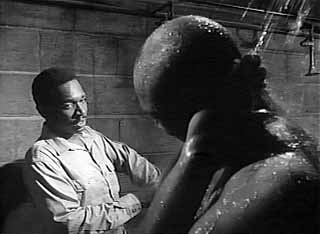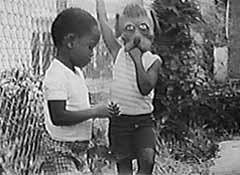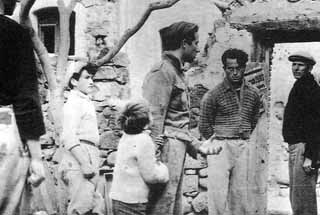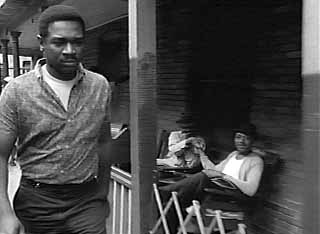|

Workers clean up after a hard day in Nothing But a Man.
Most notable of these filmmakers were Charles Burnett, Billy Woodberry, Haile Gerima and Julie Dash. Drawing on their own experiences in the black community and varied political and social discourses of the time including black nationalism, the Civil Rights Movement, the Women’s Movement, anti-war rhetoric and Marxist doctrine, these filmmakers sought an aesthetic and mode of representation and narration that spoke to the realities of black existence and the state of the black family under a hegemonic rule of white racism and subordination. They also drew upon a long and important history of black independent film making in America including the Lincoln Motion Picture Company of the 1910s, Oscar Micheaux in the 1920s and 1930s, Spencer Williams in the 1940s, and even white independent filmmakers of the 1960s including Michael Roemer and John Cassavetes who each made films dealing with American race relations in light of the Civil Rights movement from a decidedly non-hegemonic white position. James Snead writes of their project, "[T]heir films protest against the form and content of the tradition they were being taught. Their chief ambition was to rewrite the standard cinematic language of cuts, fades, frame composition, and camera movement in order to represent their own "nonstandard" vision of black people and culture. (117)
The sad reality of the body of work these filmmakers produced is that it was never widely distributed, scarcely reviewed in the mainstream press, and is now nearly impossible to find in the video store. While a fairly large body of academic writings on these films exists and the occasion retrospective springs up, such as the recently held showcase of Charles Burnett’s work at New York City’s Lincoln Center, these films are largely unknown to mainstream America.

Children at play in Killer of Sheep.
One connection that is often made, but scarcely engaged, is the influence and similarities with Italian neo-realism of the post-war era and black independent cinema of the L.A. School. Monona Wali has called Charles Burnett's Killer of Sheep (1977), "[A] masterpiece of American neo-realism"(16). Italian neo-realism mainly evolved out of the broken conditions following the German occupation and the allied liberation following World War II. Realism was an underlying concern of all neo-realist films as they strived to portray the real world as it was at that time in Italy.2 Amos Vogel wrote of neo-realism:
The great humanist masterpieces of this period...sprang directly from a social matrix in which all conventional values had been called into question if not destroyed outright, in which the individual was at odds with society, in which social, political, and moral issues were constantly raised in the daily life of the masses. In their best works, the neo-realists...raised problems of general human import, far transcending narrow national boundaries, and seemed to capture the very substance of contemporary reality in all their quivering immediacy. (17)
Many commentators have marked the influence of neo-realism on black films coming out of the L.A. School starting in the 1970s, and indeed, Vogel’s statement could be applied to the L.A. school nearly word for word.
When approaching films like Killer of Sheep, white director Michael Roemer’s Nothing But a Man (1964) or Billy Woodberry's powerful Bless Their Little Hearts (1984), one is quickly inundated with images and thematics that are directly reminiscent of Italian neo-realist films such as Roberto Rossellini's Paisan (1946) and Luchino Visconti's La Terra Trema (1948). All three of these films display many important similarities with neo-realism that heighten their impact.

Life in a fishing village
in Luchino Visconti's La Terra Trema.
Killer of Sheep finds its main character, Stan, trying to cope with his limited existence. All he has are his family and his nightmarish job in a slaughterhouse. Despite this, he perseveres in the hope of a better life bringing to mind the many terrible existences of characters in the Italian neo-realist films and their struggle to survive. Nothing But a Man finds its main character, Duff, struggling against a racist social climate, repeatedly coming up against the walls white America constructs around him. This too brings to mind Italian neo-realism’s concern with the inability of the individual to change, escape or circumvent the social strictures that bind him into place. Finally, Bless Their Little Hearts ponders extensively on the role of the physical environment on those unfortunate enough to be kept within its boundaries. Many Italian neo-realist films, particularly Visconti’s La Terra Trema (The Earth Trembles), explore how a harsh physical environment degrades the human spirit, particularly when the dominant exploit, or confine, those who must sustain themselves in it.
However, I think it important to explore the differences between these films and neo-realism as well. Mapping Nothing But a Man, Killer of Sheep and Bless Their Little Hearts along a historical line from 1964 to 1984, one finds that the digestion of neo-realist thematics changed as socio-economic and cultural issues in the black community also changed. Three themes are ever present in all these films. The representation of hope, futility and struggle are key to understanding the ideology of these films as they are highly divergent from traditional mainstream forms of film making. As each black independent film engages these themes to differing effect, one can see how these filmmakers attempted to renegotiate the black image on screen and ground it firmly in issues of realism, something that the blaxploitation films of the early 1970s sought to remove the spectator from. Simply put, blaxploitation sought to be escapist while the black independent films discussed here sought to document and comment on the reality of black existence in America. What these three films have in common is a profound reflection of realist and neo-realist ideals. They are all concerned with the black family unit and its relation to dominant white society. Nothing But a Man sets up the most direct white/black conflict but both Killer of Sheep and Bless Their Little Hearts can be seen as a continuation of that conflict as it manifested itself after the civil rights movement and the Black Power rebellion.
page 1 of 4
 
Page One Introduction
Page Two Killer of Sheep
Page Three Nothing But a Man
Page Four Bless Their Little Hearts
|








